How to check the engine of a Zanussi washing machine?
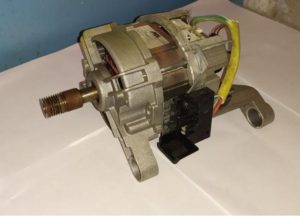 If, after starting the program, Zanussi took in water and stopped, then there are problems with the drive. In simple words, the washing machine cannot spin the drum and begin a full wash. It is impossible to immediately determine the cause of the stop: a broken belt, a faulty motor, or a control board can lead to braking.
If, after starting the program, Zanussi took in water and stopped, then there are problems with the drive. In simple words, the washing machine cannot spin the drum and begin a full wash. It is impossible to immediately determine the cause of the stop: a broken belt, a faulty motor, or a control board can lead to braking.
Testing the control module yourself at home is risky and dangerous, but checking the motor of a washing machine is quite possible. It remains to figure out where to start and how to continue.
We remove and test the electric motor
Diagnosing the engine of a Zanussi washing machine is not an easy task, but even a “newbie” can do it. But it’s better to start with theory: study the design of the machine and determine the type of installed motor. As a rule, even on modern equipment of this brand, collector motors are more often found, which are more budget-friendly and more problematic than inverter motors. A distinctive feature of the collector is the drive belt, which ensures the unwinding of the drum.
Before repairs, Zanussi must be de-energized and disconnected from the water supply.
As for the internal structure of the motor, everything is standard here: rotor, stator, shaft with lamellas and winding. On top is a housing on which electric brushes and a tachogenerator are installed. The latter is called a Hall sensor and controls the engine speed.
Having studied the design of the motor, you can begin to diagnose it. But first, we remove the device from the Zanussi case according to the following instructions:
- find a bolt on the side wall;
- use a screwdriver to pry up the plug hiding the bolt, exposing the fastener;
- unscrew the screw;
- repeat the procedure with the screw on the second side panel;
- unscrew the bolts holding the top cover of the case (the screws are located behind the protrusion of the cover on the plastic eyes);
- remove the “top”;
- unscrew the screws located on the top of the housing on the transverse bar (stiffening rib);
- remove the drain hose from the rear panel;
- disconnect the element with the power cord from the “back” by bending the tab;
- remove the backdrop from the bolts and remove it;
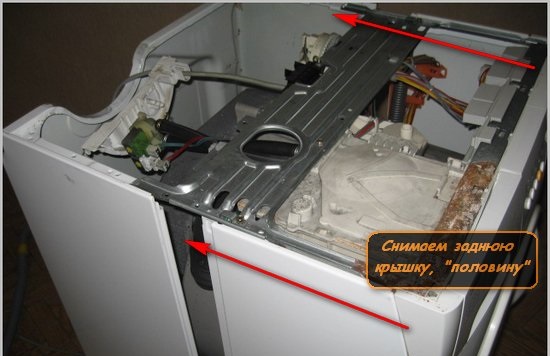
- remove the drive belt from the pulley;

- detect the engine located under the drum;
- disconnect the wiring connected to the motor;
- unscrew the 4 screws and, after swinging, remove the engine from the machine.
We put the removed engine on the table and begin diagnostics. We take a two-core wire with a cross-section of at least 2.5, stretch it from the rotor to the stator and connect to an electrical network with 220 V. If, after applying voltage, the device hums, the motor is running, if the device remains motionless, a replacement is needed.

Before you start testing, you should anticipate the risks. Firstly, this type of test is superficial and is not able to evaluate the performance of the engine at different speeds. Secondly, direct connection to the electrical network is quite dangerous, as it threatens to overheat the device. To be on the safe side, you need to include a stabilizer in the circuit, for example, a heating element. In the event of a current leak or sudden surge, the heater will take the blow, and the engine will remain unharmed.
Zanussi engine diagnostics do not end there. It is advisable to separately check the key elements of the system - electric brushes, lamellas and windings.
Assessing the condition of electric brushes
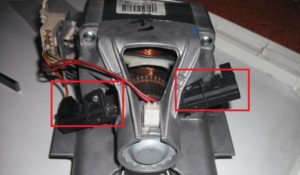 The first thing to check is the electric brushes. In most cases, they are the cause of engine braking.These are rectangular metal “cases”, inside of which graphite rods on a spring are placed. The “coals” smooth out the frictional force emanating from the device, while at the same time being erased. If the length of the tips becomes insufficient, the engine overheats and malfunctions.
The first thing to check is the electric brushes. In most cases, they are the cause of engine braking.These are rectangular metal “cases”, inside of which graphite rods on a spring are placed. The “coals” smooth out the frictional force emanating from the device, while at the same time being erased. If the length of the tips becomes insufficient, the engine overheats and malfunctions.
Diagnosis of brushes consists of measuring their length. We proceed like this:
- Unscrew the screws holding the cases;
- clamp the spring and remove the rods;
- halve each case;
- take out the tip and measure it.
Electric brushes are replaced in pairs!
The minimum length is 1.5-2 cm. If the “coal” is smaller on at least one brush, then both need to be replaced at once. The rods are selected according to the engine serial number or Zanussi itself. The best option is to remove the old cases and select new ones based on the sample.
“We climb” into the electric motor housing
 The lamellas must also be checked. These are metal plates glued to the shaft, thanks to which the required voltage is transmitted to the rotor. Over time, they can peel off, making current exchange difficult. If the detachment is minimal, then the repair will cost only sharpening. Severe deformations cannot be eliminated - only change the entire motor.
The lamellas must also be checked. These are metal plates glued to the shaft, thanks to which the required voltage is transmitted to the rotor. Over time, they can peel off, making current exchange difficult. If the detachment is minimal, then the repair will cost only sharpening. Severe deformations cannot be eliminated - only change the entire motor.
If the winding breaks, the engine also does not work. In this case, a short circuit occurs, which leads to overheating of the motor, activation of the thermistor and an emergency power outage. For diagnosis you need:
- take a multimeter;
- turn on the ohmmeter;
- lean the probes against the shaft;
- evaluate the indicators (the norm is from 20 to 200 Ohms).
Diagnostics of the control board should only be carried out by a service center!
At the “finish” we also test the stator - we connect the buzzer. If the device shows a winding break on Zanussi, the motor will have to be changed.
Interesting:
1 reader comment
Add a comment Cancel reply
Categories
Washing machine repair


For buyers

For users

Dishwasher

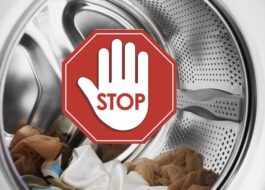

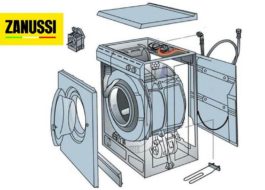
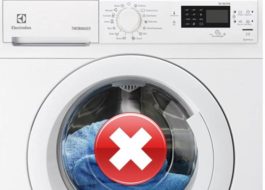












I have a block with 9 contacts. 2, as far as I understand, tacho, 2 thermo, 2 brushes and 3 contacts in the continuity with absolutely the same resistance. Where are the edges of the windings?